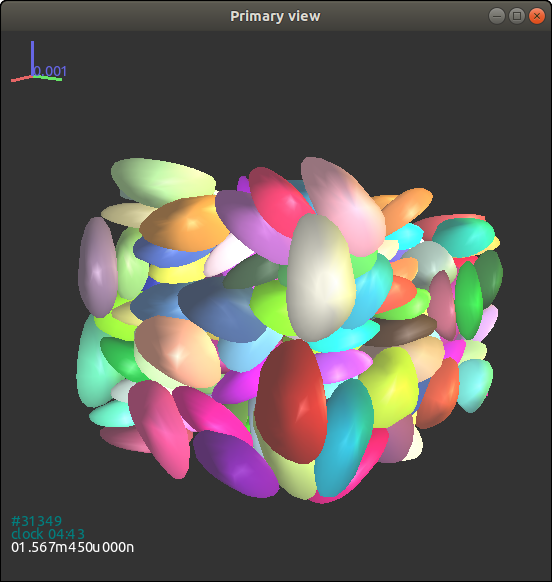1
2
3
4
5
6
7
8
9
10
11
12
13
14
15
16
17
18
19
20
21
22
23
24
25
26
27
28
29
30
31
32
33
34
35
36
37
38
39
40
41
42
43
44
45
46
47
48
49
50
51
52
53
54
55
56
57
58
59
60
61
62
63
64
65
66
67
68
69
70
71
72
73
74
75
76
77
78
79
80
81
82
83
84
85
86
87
88
89
90
91
92
93
94
95
96
97
98
99
100
101
102
103
104
105
106
107
108
109
110
111
112
113
114
115
116
117
118
|
#
from sudodem._superquadrics_utils import *
import math
import random
import numpy as np
a=1.1734e-2
isSphere=False
ap=0.4
eps=0.5
num_s=200
num_t=8000
trials=0
wallboxsize=[10e-1,0,0] #颗粒生成的盒子大小
boxsize=np.array([7e-1,7e-1,20e-1])
def down():
for b in O.bodies:
if(isinstance(b.shape,PolySuperellipsoid)):
if(len(b.intrs())==0):
b.state.vel=[0,0,-2]
b.state.angVel=[0,0,0]
def gettop():
zmax=0
for b in O.bodies:
if(isinstance(b.shape,PolySuperellipsoid)):
if(b.state.pos[2]>=zmax):
zmax=b.state.pos[2]
return zmax
def Genparticles(a,eps,ap,mat,boxsize,num_s,num_t,bottom):
global trials
gap=max(a,a*ap)
#print(gap)
num=0
coor=[]
width=(boxsize[0]-2.*gap)/2.
length=(boxsize[1]-2.*gap)/2.
height=(boxsize[2]-2.*gap)
#iteration=0
while num<num_s and trials<num_t:
isOK=True
pos=[0]*3
pos[0]=random.uniform(-width,width)
pos[1]=random.uniform(gap-length,length-gap)
pos[2]=random.uniform(bottom+gap,bottom+gap+height)
for i in range(0,len(coor)):
distance=sum([((coor[i][j]-pos[j])**2.) for j in range(0,3)])
if(distance<(4.*gap*gap)):
isOK=False
break
if(isOK==True):
coor.append(pos)
num+=1
trials+=1
#print(num)
return coor
def Addlayer(a,eps,ap,mat,boxsize,num_s,num_t):
bottom=gettop()
coor=Genparticles(a,eps,ap,mat,boxsize,num_s,num_t,bottom)
for b in coor:
#xyz = np.array([1.0,0.5,0.8,1.5,1.2,0.4])*0.1
xyz = np.array([1.0,0.5,0.8,1.5,0.2,0.4])*0.1
bb=NewPolySuperellipsoid([1.0,1.0],xyz,mat,True,isSphere)#
bb.state.pos=[b[0],b[1],b[2]]
bb.state.vel=[0,0,-1]
O.bodies.append(bb)
down()
p_mat = PolySuperellipsoidMat(label="mat1",Kn=1e5,Ks=7e4,frictionAngle=math.atan(0.3),density=2650,betan=0,betas=0) #define Material with default values
wall_mat = PolySuperellipsoidMat(label="wallmat",Kn=1e6,Ks=7e5,frictionAngle=0.0,betan=0,betas=0) #define Material with default values
wallmat_b = PolySuperellipsoidMat(label="wallmat",Kn=1e6,Ks=7e5,frictionAngle=math.atan(1),betan=0,betas=0) #define Material with default values
O.materials.append(p_mat)
O.materials.append(wall_mat)
O.materials.append(wallmat_b)
O.bodies.append(utils.wall(-0.5*wallboxsize[0],axis=0,sense=1, material = wall_mat))#left x
O.bodies.append(utils.wall(0.5*wallboxsize[0],axis=0,sense=-1, material = wall_mat))#right x
O.bodies.append(utils.wall(-0.5*boxsize[1],axis=1,sense=1, material = wall_mat))#front y
O.bodies.append(utils.wall(0.5*boxsize[1],axis=1,sense=-1, material = wall_mat))#back y
O.bodies.append(utils.wall(0,axis=2,sense=1, material =wallmat_b))#bottom z
#O.bodies.append(utils.wall(boxsize[0],axis=2,sense=-1, material = wallmat_b))#top z
newton=NewtonIntegrator(damping = 0.3,gravity=(0.,0.,-9.8),label="newton",isSuperquadrics=2)#isSuperquadrics=2 for Poly-superellipsoids
O.engines=[
ForceResetter(),
InsertionSortCollider([Bo1_PolySuperellipsoid_Aabb(),Bo1_Wall_Aabb()],verletDist=0.2*0.1),
InteractionLoop(
[Ig2_Wall_PolySuperellipsoid_PolySuperellipsoidGeom(), Ig2_PolySuperellipsoid_PolySuperellipsoid_PolySuperellipsoidGeom()],
[Ip2_PolySuperellipsoidMat_PolySuperellipsoidMat_PolySuperellipsoidPhys()], # collision "physics"
[PolySuperellipsoidLaw()] # 接触力本构模型
),
newton
]
O.dt=5e-5
#生成颗粒
Addlayer(a,eps,ap,p_mat,boxsize,num_s,num_t)#Note: these particles may intersect with each other when we generate them.
#显示设置。用户可以通过界面窗口来直接更改对应设置。
sudodem.qt.Gl1_PolySuperellipsoid.wire=False
sudodem.qt.Gl1_PolySuperellipsoid.slices=10
sudodem.qt.Gl1_Wall.div=0 #hide the walls
|
 组合超级椭球及其形状参数
$r_x^+=1.0, r_x^-=0.5, r_y^+=0.8, r_y^- = 0.9, r_z^+ = 0.4, r_z^- = 0.6$
(a) $\epsilon_1=0.4, \epsilon_2=1.5$, (b)
$\epsilon_1=\epsilon_2=1.0$, (c)
$\epsilon_1=\epsilon_2=1.5$.
组合超级椭球及其形状参数
$r_x^+=1.0, r_x^-=0.5, r_y^+=0.8, r_y^- = 0.9, r_z^+ = 0.4, r_z^- = 0.6$
(a) $\epsilon_1=0.4, \epsilon_2=1.5$, (b)
$\epsilon_1=\epsilon_2=1.0$, (c)
$\epsilon_1=\epsilon_2=1.5$. {#figpolysuperpacking
width=“10cm”}
{#figpolysuperpacking
width=“10cm”}